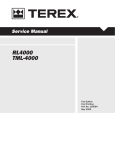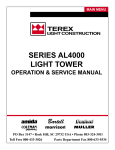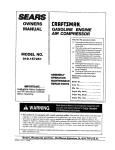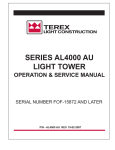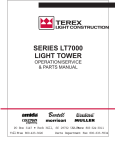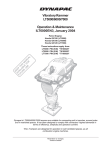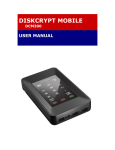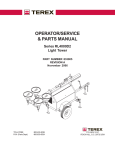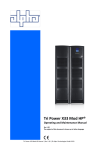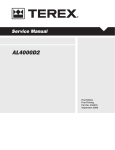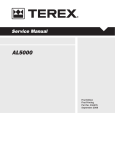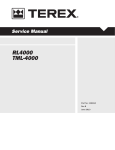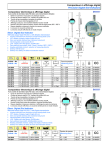Download PN SFMAL4D1 - Genie Industries
Transcript
SERIES AL4000D1 LIGHT TOWER OPERATION/SERVICE & PARTS MANUAL After Serial Number: FKF-13923 PART NUMBER SFMAL4D1 REVISION B SEPTEMBER 2006 1 TABLE OF CONTENTS Receiving and Set-up Safety Alert Symbols....................................................................... 3 General Safety................................................................................ 4-8 Check Out on Receipt/Delivery........................................................ 11 Serial Number Regoster.................................................................. 12 TEREX Amida Light Tower Model Coding System ............................ 13 Recommended Engine Oil and Fuel ..................................................... 14 Operating Instructions Light Tower Operating Instructions ...................................................... 15-19 Engine (see manufacturer’s handbook) Generator (see manufacturer’s handbook) Parts Identification Drawings Trailer and Fuel Tank ............................................................................ 41-42 Axle and Wheels .................................................................................. 43 Cabinet and Attachments ..................................................................... 44-46 Tower and Related Parts ...................................................................... 47-56 Engine and Generator ........................................................................... 57-61 Electrical Box ....................................................................................... 62 Floodlight Fixtures / Ballasts ................................................................. 63-64 Hitches ................................................................................................. 65 Options ................................................................................................. 66-77 Wiring Diagrams Fixture with Joy Connector (MH or TH) ............................................. 33 Metal Halide Ballast with Connector ................................................... 34 High Pressure Sodium Ballast with Connector .................................... 35 Wiring .................................................................................................. 36-40 Troubleshooting Guide Specifications, Routine Maintenance, Wind Loading, Torque Specs .... 24-27 Criteria for Replacement of Wire Rope ............................................... 28 Broken Cable Replacement Procedure ................................................ 29-32 Light Fixture Troubleshooting ............................................................... 20-22 TEREX Amida Numbered Wiring System ........................................... 23 Engine (refer to manufacturer’s handbook) Generator (refer to manufacturer’s handbook) Warranty Information Warranty Procedure……………………………………………..........10 Warranty………………………………………………………........... 9 2 SAFETY ALERT SYMBOLS MEANS: ATTENTION! BE ALERT! YOUR SAFETY IS INVOLVED THIS SAFETY SYMBOL IS USED FOR IMPORTANT SAFETY MESSAGES. WHEN YOU SEE THIS SYMBOL, FOLLOW THE SAFETY MESSAGE TO AVOID PERSONAL INJURY OR PROPERTY DAMAGE. UNDERSTANDING SIGNAL WORDS A signal word - DANGER, WARNING or CAUTION is used with the safety alert symbol. DANGER Identifies the hazard or unsafe practice that will result in severe injury or death. WARNING Identifies the hazard or unsafe practice that could result in severe injury or death. CAUTION Identifies the hazard or unsafe practice that could result in minor injury or property damage. NOTICE Identifies important installation, operation or maintenance information. 3 GENERAL SAFETY DO NOT OPERATE THE AL4000 LIGHT TOWER WITHOUT READING THIS OPERATOR’S MANUAL. SAFETY ALERT SYMBOL Stop and take time to read ALL Safety alert messages. Follow the safety messages to avoid personal injury or property damage. ACCIDENT PREVENTION Use protective clothing and safety equipment. Always wear approved safety equipment such as gloves, safety boots, safety hard hat, goggles, ear protection, and dust masks when necessary. Wear protective clothing that is snug and belted where required. UNAUTHORIZED WELDING UNAUTHORIZED WELDING CAN CAUSE STRUCTURAL FAILURE OR PERSONAL INJURY. DO NOT weld on any structural member. Any unauthorized welding or repair procedure will void the warranty. 4 GENERAL SAFETY FUELING ALWAYS handle fuel with care. It is highly flammable. ALWAYS stop engine before refueling. Fill fuel tank outdoors. Be sure the fuel supply has a positive shut-off valve. DO NOT replace fuel lines with materials different from those supplied as original equipment. FIRES CAN CAUSE SEVERE PERSONAL INJURY OR MACHINE DAMAGE. Prevent fires by keeping the light tower and its surrounding area clean. DO NOT refuel while smoking or when near open flame or sparks. DO NOT refuel the engine when it is hot. Allow to cool for several minutes before refueling. DO NOT spill fuel inside the engine compartment. If fuel has leaked, wipe it up and have leak repaired before next use. Have a fire extinguisher nearby. Be sure the extinguisher is properly maintained and be familiar with its use. Extinguishers rated ABC by the NFPA are appropriate for all applications. 5 GENERAL SAFETY Guard Against Electrical Shock Equipment produces high voltage electricity (up to 480 volts) that can produce a fatal shock to a person who accidentally places their self in the electrical circuit. Use every precaution to avoid contact with the high voltage electrical circuit. Beware of a cut or damaged power cord. Have a qualified electrician replace immediately. Take extra precautions when troubleshooting electrical problems. When troubleshooting indicates a malfunction in the high voltage AC system, pass the troubleshooting task on to a qualified and trained electrician. Disconnect electrical power and turn off engine before removing protective covers on high voltage enclosures. Understand that the electrical circuits in this light tower complete their paths back to the generator within the equipment. The neutral conductor at the generator is bonded to the equipment frame. Ground wires within the system are also bonded to the equipment frame. Only use a multimeter (or voltmeter) with two well-insulated probes rated for 750 volts each. Keep one hand in your pocket when touching the multimeter probe to hot conductors. This will prevent electricity from passing into one hand and out the other, a path that takes the electricity across the heart. Always disconnect power from the circuit being measured before connecting test leads to high voltage points. Do not try to position both probes at once. Instead, clamp the common insulated alligator clip to a neutral wire and then probe for voltages with the other probe. Never clamp to a hot wire since a severe shock could be received by contact with the other probe. Inspect the ground cable between the generator set and the frame. If damaged, replace immediately. Treat all conductors as potentially hot, especially when troubleshooting malfunctioning equipment. Jewelry should be removed before working around live conductors. Proceed through the circuitry systematically, operating only one section at a time. Use tools with insulated handles when working within the reach of live conductors. Maintain a good footing. If you slip, or a tool drops, do not grab for it if live conductors are within reach. Concentrate on the task until the danger from high voltage is removed. 6 Guard Against Battery Hazards Lead acid batteries can be dangerous. The sulfuric acid in the battery can cause severe skin and eye burns. The hydrogen gas emitted during charging can explode if an arc or flame is present near the battery. Use precautions to prevent acid burns or explosive conditions. Do not smoke while servicing batteries. Do not allow tools to touch battery terminals and create an arc. Do not test battery voltage by setting up a brief arc at the terminals. Use a multimeter instead. Disconnect the negative terminal of the battery when working on the engine or other parts to prevent accidental arcing. Disconnect the negative cable at the end away from the battery. Always wear eye protection when servicing the battery. When charging the battery, do not remove the vent caps. If acid does get on skin or in eyes, immediately flush under running water, and then obtain medical help as soon as possible. Guard Against Fire Hazard Use caution with diesel fuel and motor oil because of fire hazards. Do not fill fuel tank while engine is running. Do not smoke or use open flame near the unit or the fuel tank. Be sure the fuel supply has a positive shut-off valve. Do not replace fuel lines with materials different from those supplied as original equipment. Protect The Environment And Practice Good Industrial Hygiene Exhaust Gases Are Toxic. Do not use indoors unless properly ventilated. Provide an adequate exhaust system to properly expel discharged gases. Check exhaust system regularly for leaks. Ensure periodically that the exhaust manifolds are secure and not warped. Make sure the unit is well ventilated. Prevent pollution by catching used oil in a container for proper disposal. Wash hands to remove oil and fuel. Practice good industrial hygiene. Do Not Touch Hot Parts The exhaust manifold and tailpipe are very hot. Parts of the engine are also hot. Avoid touching hot parts of the engine or tailpipe. Use protective gloves when handling hot parts. 7 Be Alert And Attentive To The Task Read the safety instructions and operating procedures before attempting to troubleshoot or work on this unit. Also read the engine manual, which is a separate booklet that is provided with this manual. Do not work on this equipment when mentally or physically fatigued. Do not work on this equipment when under the influence of performance impairing drugs or alcohol. If this manual becomes lost, order a new one from TEREX-Amida so future operation and maintenance personnel may read these instructions. Beware of Moving Parts Avoid being hit or pinched by the moving parts of this unit. Loose jackets, shirts, neckties, or sleeves should not be worn while working on or running a unit. Only remove guards or protective devices from unit temporarily to gain access for maintenance. Always replace guards and protective devices promptly (Prior to Operation). Keep your hands away from moving parts. Particularly, be sure to keep hands clear of the blower and alternator belts when the engine is running. Beware of Traffic Hazards Stand clear of traffic when starting or checking the unit along the road. Check the fuel tank, oil pan, and fuel and oil lines for leaks that would spill fuel or oil on the road. Check fasteners and mounting brackets periodically to ensure all are tight and nothing is in danger of falling off during transit. Use Only Equal Replacement Parts When a part fails and needs to be replaced only use equivalent size, length, thread, grade, and material. Replace stainless steel fasteners with stainless steel fasteners. The engine may use metric or SAE bolts, but all other bolts are generally SAE thread. Be sure to use Grade 8 bolts and nuts to mount the genset to the trailer. Replace the fuel and oil hoses with items of equal material, diameter and length. Contact the manufacturer, TEREX Light Construction, regarding replacement parts to ensure a correct repair. Use Caution Working Near Lamps Metal halide lamps produce short wave ultra-violet radiation and can cause serious skin burn, or eye inflammation if the outer envelope of the lamp is broken or punctured. Do not use where people will remain for more than a few minutes unless adequate shielding or other safety precautions are used. 8 TEREX LIGHT CONSTRUCTION P.O. Box 3147 Rock Hill, S.C. 29732 MANUFACTURER’S LIMITED WARRANTY TEREX LIGHT CONSTRUCTION (“TLC”) warrants to the original purchaser that such equipment, accessories, parts and other products manufactured by TLC will be free from defects in workmanship and material for a period of one (1) year after the date of first delivery or for one thousand (1,000) hours of use, whichever comes first; provided that Buyer sends TLC notice of such defect within thirty (30) days of its discovery. Should defects be discovered, the Buyer must clearly establish that (I) the equipment, parts, etc. have been properly installed and set up, maintained and operated within the limits of rated and normal usage and (II) the defect did not result in any manner from the intentional or negligent action or inaction of Buyer. Buyer must also return the defective item or items to TLC, Rock Hill, SC for inspection at TLC’s request. If Buyer cannot establish that conditions (I) and (II) have been met, then this warranty shall not cover the alleged defect. Failure to give notice of defect within such period shall be a waiver of this Warranty and any assistance rendered thereafter shall not extend or revive it. THIS WARRANTY IS LIMITED TO THE BUYER AND IS NOT ASSIGNABLE OR OTHERWISE TRANSFERABLE. TLC MAKES NO WARRANTY WITH RESPECT TO PARTS, COMPONENTS, EQUIPMENT AND ACCESSORIES NOT MANUFACTURED BY TLC SUCH AS FIXTURES, BALLASTS, ENGINES, HYDRAULIC PUMPS, FUEL PUMPS, ALTERNATORS, GENERATORS, WINCHES, TIRES AND ELECTRICAL COMPONENTS. Accessories, assemblies and components included in products of TLC, which are not manufactured by TLC, are subject only to the warranty of their respective manufacturers. TLC makes no other warranty, express or implied, and makes no warranty of merchantability or fitness for any particular purpose. This warranty shall not cover misuse, alteration, abuse, negligence, accident, acts of God, sabotage or any item in which serial numbers have been altered, defaced or removed, but shall be limited to repair or replacement of those parts which, upon inspection by TLC, appear to have been defective in material or workmanship. TLC’s liability and Buyer’s sole and exclusive remedy for a failure of goods to perform as warranted and/or for any and all other claims arising out of the purchase and use of the goods, including negligence on the part of TLC, shall be limited to the repair or replacement of defective parts returned, transportation prepaid to TLC. TLC shall in no event be liable for incidental or consequential or other damages or losses resulting from a breach of warranty such as, but not by way of limitation, labor costs, loss of profits, loss of use of other than equipment, third party repairs, personal injury, emotional or mental distress, improper performance of work, penalties of any kind, loss of service of personnel, or any other damages or losses which may be experienced by the Buyer. A product warranty certificate must be filled out in its entirety and returned to TLC in order to process any warranty claims submitted. THIS WARRANTY IS EXPRESSLY IN LIEU OF AND EXCLUDES ALL OTHER WARRANTIES, EXPRESSED OR IMPLIED (INCLUDING ANY WARRANTY OF MERCHANTABILITY AND FITNESS OF ANY PRODUCT OR GOODS FOR A PARTICULAR PURPOSE) AND ALL OTHER OBLIGATIONS OR LIABILITIES ON TLC’S PART, AND TLC NEITHER ASSUMES NOR AUTHORIZES ANY OTHER PERSON TO ASSUME FOR TLC ANY OTHER LIABILITY IN CONNECTION WITH THE SALE OF TLC’S PRODUCTS. THERE ARE NO WARRANTIES WHICH EXTEND BEYOND THE DESCRIPTION ON THE FACE HEREOF. 9 WARRANTY PROCEDURE The specific language of this warranty will determine TEREX LIGHT CONSTRUCTION's obligation in connection with its product. The information presented below should be used as a general guide for implementation of policy. In the event of a component failure during the warranty period it should be repaired as soon as possible, preferably at an authorized TEREX LIGHT CONSTRUCTION service center. If component is manufactured by a company other than TEREX LIGHT CONSTRUCTION, such as Deutz, Honda, Isuzu, Leroy Somer, Lister Petter, Lombardini, Wisconsin, etc., the applicant should pursue repair and/or reimbursement through that manufacturer, and its dealer/distributor network. To file a claim with TEREX LIGHT CONSTRUCTION, an APPLICATION FOR WARRANTY ADJUSTMENT (AWA) form must be completed in it’s entirety. Return the completed form within fourteen days of the repair to: ATTENTION: WARRANTY TEREX LIGHT CONSTRUCTION 590 Huey Road Rock Hill Industrial Park Rock Hill, SC 29730 TEREX LIGHT CONSTRUCTION will review the AWA form. Should we desire to inspect the defective parts, we will issue you a return authorization for the defective parts. After inspecting the defective part(s), and it is determined that warranty is due, we will then, at the discretion of TEREX LIGHT CONSTRUCTION , credit the applicants account or send replacement parts. TEREX LIGHT CONSTRUCTION warranty reimbursements: 1. $40.00 for each hour’s labor we allow toward a repair. 2. Distributors cost of parts not more than the price currently available from TEREX LIGHT CONSTRUCTION. 3. One way surface freight charges on parts returned to TEREX LIGHT CONSTRUCTION. Many repairs are assigned a predetermined labor schedule which is an average time in which a skilled technician should be able to make a repair. TEREX LIGHT CONSTRUCTION will reimburse not to exceed the predetermined number of hours for a particular repair. TEREX LIGHT CONSTRUCTION does not reimburse for: 1. 2. 3. 4. Travel, travel time, nor travel labor. Mileage. Excessive diagnostic time. Repairs of defects, malfunctions, or failures resulting from accidents, abuse, misuse, modifications, alterations, improper servicing or lack of performance of required maintenance service. 5. Repairs where defective parts were not shipped back when requested by TEREX LIGHT CONSTRUCTION. 6. Regular maintenance such as parts or labor for oil changes, filter changes or filters. 7. Repairs where defective parts were not received by TEREX LIGHT CONSTRUCTION after TEREX LIGHT CONSTRUCTION issued a return authorization. TEREX Light Construction P.O.Box 3147• Rock Hill, S.C. 29731 USA • Phone 803-324-3011 • Fax 803-366-1101 10 TEREX-AMIDA, INC. CHECK OUT ON RECEIPT OF DELIVERY: The tower will be serviced, tested and ready for operation when received except for export units and skid mount units which are knocked down for shipping (export units are sometimes shipped with dry batteries). TEREX-Amida recommends the following checks: A. INSURE THERE IS NO FREIGHT HANDLING DAMAGE which should be charged against the carrier. B. INSURE THE MANUALS ARE IN THE POCKET PROVIDED INSIDE THE UNIT. C. REVIEW THE MANUALS FOR SAFETY AND OPERATING PROCEDURES. D. CHECK THE ENGINE OIL, COOLANT (IF LIQUID COOLED) AND FUEL LEVELS. E. OPERATE THE TOWER IN ACCORDANCE WITH OPERATING INSTRUCTIONS. EXPORT: Assemble according to the instructions enclosed. 5 11 TEREX LIGHT CONSTRUCTION PORTABLE LIGHT TOWER OPERATION AND SERVICE MANUAL This Operation and Service Manual contains information pertaining to the operation and maintenance of your Terex Light Tower. We suggest that you read this manual carefully prior to operating the tower. This manual should be retained and referred to for operation, maintenance, and ordering parts When ordering parts, PLEASE INCLUDE THE MODEL AND SERIAL NUMBER located on the nameplate of the tower. For major repair and service or other information, contact your local Terex dealer or write to: Terex Light Construction P.O. Box 3147 590 Huey Road Rock Hill, SC 29730 Telephone: (803) 324-3011 FAX: (803) 366-1101 When returning parts for credit please contact the factory for Return of Goods Authorization. Terex Model Number _______________________ Serial Number ____________________ Engine Model Number _______________________ Serial Number ____________________ Generator Model Number ____________________ Serial Number ____________________ Sold to: _____________________________ Ship to: _________________________ _____________________________ _________________________ _____________________________ _________________________ _____________________________ Production Date: _________________ _____________________________ Work Order Number ______________ _____________________________ Shipping Date ___________________ _____________________________ In Service Date __________________ Options: _____________________________ _____________________________ When this unit left the factory the engine was filled with engine oil grade __________ 12 IMPORTANT WHEN REQUESTING TECHNICAL HELP AND ORDERING REPLACEMENT PARTS THE MODEL AND SERIAL NUMBER ARE NECESSARY. REFER TO THE TEREX SERIAL NUMBER TAG ON THE UNIT FOR CORRECT MODEL NUMBER AND SERIAL NUMBER. ______________________________________________________________________________ MODEL NUMBER IDENTIFICATION Sample: Light Tower Product Line AL4 Tower Series AL4000 (AL4) = 30 Foot Basic Tower with winch in cabinet AL5000 (AL5) = 30 Foot Basic Tower with in-cabinet light storage and door insulation LT7000 (LT7) = 30 Foot Deluxe Hydraulic Tower w/optional Acoustic Enclosure and Complete Instrumentation kW Rating (080 is 8.0 kW) Diesel (D) Number of Lights Type of Lights HPS = High Pressure Sodium MH = Metal Halide TH = Tungsten Halogen European Version (AL4000 Only) 13 080 D 4 MH CE RECOMMENDED ENGINE OIL & FUEL KUBOTA D905 DIESEL ENGINE Engine oil should be MIL-L-2104C or have properties of API classification of CD grades or higher. Change the type of engine oil according to the ambient operating temperature: Above 77°F (25°C) 32°F to 77°F (0 to 25°C) SAE 30 SAE 20 Below 32°F (0°) SAE 10W SAE 10W-30 Use #2 diesel fuel. NOTES: 1. The temperatures in the table are the ambient temperatures at the time when the engine is started. If the running ambient temperatures are much higher than the starting temperatures, a compromise must be struck and a higher viscosity oil used. Multi-grade oils overcome the problem, provided they possess a suitable specification. 2. MIL-L-2104B or MIL-L-2104C or API CD must also be used if the sulfur content of the fuel exceeds 0.5%. 3. Always use a reputable brand of diesel fuel. The sulfur content should be below 0.5% (higher sulfur content would require more frequent oil changes). Observe strict cleanliness when filling the fuel tank. 4. Check the engine oil level before starting the engine or more than five minutes after it has been stopped. Remove the dipstick, wipe clean, reinsert it, take it out again, and check the oil level. If the oil level is too low, remove the oil filler cap and add new oil until the FULL line on the dipstick is reached. 14 MODEL AL4000 OPERATING INSTRUCTIONS READ ALL DIRECTIONS IN MANUAL CAREFULLY BEFORE OPERATING EQUIPMENT DO NOT RAISE TOWER IN THE VICINITY OF OVERHEAD POWER LINES! O PE RAT I N G I N S T R U C T I O N S I. MOVE LIGHT TOWER TO DESIRED LOCATION KEEPING THE FOLLOWING IN MIND: A. The light tower should not be placed where those working under the light are either: 1) Forced to look into the light regularly. 2) Forced to work with their backs to the light (shadows will block the light from the work area). B. The area where the tower is positioned should be relatively level. C. The light tower should be located on the same level or on ground higher than the area being lighted (higher light mounting heights reduce the shadow length). D. Unit should be level to ensure smooth trouble-free tower telescoping. Tower may not telescope down properly when unit is not level. II. UNHITCH FROM THE TOWING VEHICLE AS FOLLOWS: A. Engage the trailer braking system, especially if trailer is not on level ground. CAUTION: If electrical or manual braking system is not supplied, chock the wheels instead. B. Swing the tongue jack into position and raise the tongue off the towing vehicle. III. LEVEL THE TRAILER, USING THE JACKS AS FOLLOWS: A. Extend the rear outriggers until the springs lock into place. Swing the jack on each outrigger into vertical position. B. Start at the highest jack position. Rotate the jack handle until the jack foot touches the ground. C. Raise the other jacks to level trailer... tower from tipping over backwards when raised. IV. ...insure that the rear jacks are down to prevent the DRIVE GROUNDING ROD INTO EARTH 15 V. INSTALL THE FLOODLIGHTS ON THE CROSSBEAM A. Remove the light fixtures from the tower by removing detent pin and rotating the clamp to free the lights. Install them on the cross arm studs with the lens facing the ground. B. The cord on the fixture should be on the side closest to the trailer so the cord entry is beneath the fixture when the tower is raised ( this reduces moisture problems and ensures the water weep hole in the fixture is down). C. Set the vertical aim for each light fixture by adjusting the light fixtures and tightening the lower bolt. D. Set the spread between the light fixtures horizontal aiming by adjusting the fixtures and tightening the wing nut. E. The unit may be transported with the light fixtures mounted on the cross-arm if they are pointed toward the ground. "T " B O LT F IX T U R E TR A V E L S TO R A G E B R A C K E T S TR A V E L LO C K IN G P IN P IV O T P IN T E LE S C O P IN G L O C K IN G P IN K IC K -O U T S P R IN G V E R TIC A L LO C K IN G P IN VI. RAISING THE TOWER (refer to drawing above) A. Remove the tower travel-locking pin from the cradle at the rear of the cabinet. B. Aim the fixture, both horizontally and vertically, to the estimated angles that will light the work area. C. Using the winch, raise the tower to the vertical position. The tower-locking pin at the base of the pivot post will lock automatically and you will hear it “snap” into place. Insert manual pin into locking device. D. Release the tension on the cable by backing the winch off slightly and pull the telescoping locking pin on the galvanized tower section. Hold this out while turning the winch to raise the tower. After the tower has telescoped slightly, the locking pin can be released. Raise the tower to the desired height. DO NOT ATTEMPT TO LEAN THE TOWER DOWN BELOW 45° WHEN IT IS EXTENDED-SERIOUS DAMAGE MAY OCCUR! 16 VII. START THE ENGINE / GENERATOR SET A. Ensure the circuit breakers are turned “OFF”. This prevents the engine from starting under load and prevents electrical equipment from being subjected to improper voltage and frequency. B. Check the oil, fuel, and coolant (if liquid cooled) levels. If the fuel tank is empty, it may be necessary to bleed the fuel line after filling the tank (see engine instruction book for procedure). C. Turn the ignition switch to the “ACC” position (see diagram below). Press the preheat pushbutton for a maximum of 20 SECONDS. Do not engage the preheat button longer than the time specified or damage may occur. D. Turn the ignition switch to the “START” position to engage the engine. After the engine starts, release the switch so that it returns to the “RUN” position. Let the engine come up to speed and stabilize (review the engine operating procedures in the manufacturers handbook). Note: If engine will not start, leave switch in run position for additional 10-20 seconds to completely prime the fuel system. Then repeat step “C” and start engine. E. Turn on the main circuit breaker. VIII. TURN ON THE FLOODLIGHTS A. Turn the circuit breakers “ON” and check to ensure that all lamps come on. Allow a minimum of two (2) minutes for lamps to reach full luminance. B. If required, rotate the tower to aim the lights as desired. Tighten the tower rotating locking bolt. C. Adjust the tower vertically and adjust lighting direction of individual fixtures if required. IX. TURN OFF THE FLOODLIGHTS A. If operating, turn light circuit breakers off. B. Turn engine switch to “OFF” to shut down the engine. Do not shut down engine prior to turning lights off. C. Allow lamps to cool at least ten (10) minutes before moving the tower to avoid breaking lamps. 17 X. LOWERING THE TOWER TO TRAVELING POSITION A. Using the winch, telescope the tower down to its fully retracted position until the telescoping locking pin snaps into place. B. Ensure that the telescoping locking pin locks before pulling the vertical lock pin at the bottom of the pivot post. This ensures the tower is completely lowered and cannot be damaged by telescoping out while in the travel position. C. Loosen rotating lock. D. Rotate the tower so that the groove in the galvanized ring at the pivot is pointing to the rear of the trailer to enable the tower to be lowered into the travel position. E. Tighten rotating l ock. F. Pull the vertical locking-pin at the base of the pivot post (the kick-out spring should provide sufficient pressure to start the tower pivoting over). G. Let out on the winch cable to lower the tower into the cradle. H. Insert the rear tower horizontal travel-locking pin into the cradle. XI. RELOCATING LIGHT TOWER TO NEW LOCATION A. Insure that tower has been properly lowered (see section VII) and locking pins are engaged. B. C. Insure all fixtures are pointed toward the ground, or mounted on the fixture storage brackets on the lower tower section. All jacks must be raised and all outriggers locked into travel position. D. Insure that the coupler is properly secured to the towing vehicle and safety chains are attached (if supplied). Release any manual braking mechanism (if supplied). E. Do not tow at excessive speeds (60 mph – 100-kmh maximum) as the weight of the light tower can cause loss of vehicle control, especially under emergency stopping conditions. The standard trailer has no towing brakes; therefore allow extra distance for stopping. 18 XII. USE OF LIGHT TOWER AUXILIARY POWER A. One (1) 30amp/240v Twist-Lock and (1) 15 amp/120v receptacles are provided for auxiliary power. B. Total auxiliary power cannot exceed main circuit breaker rating. Each lamp operating consumes 10 amps of current @ 120 vac. C. Before plugging in auxiliary power cords, feed them up through the trailer frame and attach to receptacles. Close the cabinet doors to protect control panel and other components from weather (see Miscellaneous Specifications and Routine Maintenance section for power control details). 19 LIGHT FIXTURE TROUBLESHOOTING Do not open fixtures while light circuit breaker is “ON”. Allow lamp to cool before touching. **TAKE EXTRA PRECAUTIONS WHEN TROUBLESHOOTING ELECTRICAL PROBLEMS** A. Only use a voltmeter with two well-insulated pin probes rated for 600 volts. B. Treat all conductors as potentially hot. C. Proceed through circuits systematically, operating only one section at a time. D. Before disconnecting ballast, turn off circuit breaker and wait 30 seconds for capacitor to discharge. E. If all the lights are out and all the ballasts are receiving power, suspect burned out power cable. SYMPTOM CAUSES CORRECTIVE ACTION LAMP WILL NOT START Check Ballast Status Light a.Input lights should be on. This confirms power is going to the ballast. b.Output lights should be on. This confirms power is coming from ballasts. c.Output lights should be normal brightness. If one or moreof the output lights stay extra-bright, then the lamp is notstriking. d.Use this knowledge to diagnose problem. e.If ballast status light is out, but the floodlight lamp is working, suspect burned out ballast status lamp and replace Lamp loose in socket Inspect lamp base to see if there is arcing at center contact button. Tighten lamp snugly. Check socket for damage. Replace if defective. Floodlight Plugs not tight Check plug and receptacle. Tighten if loose. Defective Ballast Interchange ballast plugs in generator enclosure. If lamp starts, replace ballast. Check ballast wiring diagram. Check for swollen capacitors, charred wiring, core and coil, or other signs of excessive heat. Low Voltage Check line voltage at ballast input. Voltage should be within 10% of nameplate rating when operating at normal load. Increase supply voltage or remove external load. Improper ballast Proper HID lamps will perform erratically or fail to start on an improper ballast. The ballast nameplate data should agree with the line voltage and lamp used. Improper ballast will cause lamp to fail. Improper lamp operating position Operating position should agree with lamp etch. A BUHOR lamp can be operated base up vertical to and including the horizontal and BD can be operated base down and vertical to, approaching, but not including the horizontal. A lamp operated beyond the specified position may not start. Lamp has been operating; cool down time insufficient HID lamps require 4 to 8 minutes cool-down time before restarting. Switch off breaker and allow lamp to cool. 20 LIGHT FIXTURE TROUBLESHOOTING (cont’d) SYMPTOM CAUSES CORRECTIVE ACTION LAMP STARTS Defective Lamp SLOWLY (ARC DOES NOT STRIKE WHEN SWITCH IS FIRST TURNED ON) Lamp may glow for extended period of time. Replace after checking voltage and ballast. CIRCUIT Short circuit BREAKER TRIPS ON LAMP START-UP Checking wiring against diagram. Check for shorts. LAMP LIGHT OUTPUT LOW Normal lamp depreciation Replace lamp Dirty lamp or fixture Clean lamp and fixture (Let cool sufficiently before cleaning) Defective ballast Interchange ballast plugs in generator enclosure. If lamp returns to normal light output, replace ballast. Check for swollen capacitors, charred wiring, core and coil, or other signs of excessive heat. Wrong Voltage Check voltage at ballast input. Voltage should be within 10% of nameplate rating. Check wiring connections for voltage loss. Check socket contact point. Improper ballast Check ballast nameplate against lamp data. Normal lamp depreciation Lamp color and brightness decreases and colors change slightly as lamps age. Spot replacement with new lamps may cause noticeable differences in lamp colors. Group replacement minimizes color differences. Dirty fixture Dirty fixtures will cause lamps to appear different in color. Clean fixture. Wrong lamp Check data on lamps, which appear different in color. Replace with correct color lamp. Over voltage from power supply Check voltage at ballast. Check for current or voltage surges. Check for shorted capacitors and replace if defective. Improper ballast Lamp operated on ballast designed for higher wattage lamp. Check ballast nameplate against lamp data. LAMP COLORS DIFFERENT ARC TUBE DISCOLORED OR SWOLLEN 21 LIGHT FIXTURE TROUBLESHOOTING (cont’d) SYMPTOM CAUSES CORRECTIVE ACTIONS SHORT LAMP LIFE Lamp damaged Check for outer bulb cracks. If air enters outer bulb, arc tube may continue to burn for 100 hours before failure. Check for bulb cracks where glass meets the base due to tightening lamp too firmly in socket. Look for broken arc tube or loose metal parts. Replace lamp. Improper ballast Ballast nameplate data should agree with lamp line voltage and lamp use. If improper ballast is used, the lamp life will be shortened. A mismatch may also cause the ballast to fail. Improper ballast Improper ballasting can cause flickering or erratic operation. In the start-up period the lamp may ignite, start to warm-up and then extinguish (cycle). New lamp Under certain conditions new lamps may “cycle”. Usually after three (3) tries to start at 30 to 60 second intervals, lamps will stabilize and operate satisfactorily. Defective lamp Replace lamp. High spike ballast Ballast produce high spike current. Measure with oscilloscope. Replace ballast as required. LAMP FLICKERS AND GOES OUT INTERMITTET 22 TRACEABLE NUMBERED WIRING SYSTEM (Using plug in ballasts to troubleshoot) When troubleshooting the preceeding problems, minimize down time by following the traceable numbered wiring system, always follow these steps: STEP1: Insure all ballasts, which are numbered, are plugged into lead wires with corresponding numbers. STEP 2: Looking at the lights from the glass side and following the diagram below, plug each fixture into the appropriately numbered plug at the top of the tower. By adhering to the traceable numbered wiring system, troubleshooting, fixture aiming, and fixture control will follow a standard predictable pattern. 23 TEREX Amida Model AL4000 Light Tower – General Specifications And Routine Maintenance TEREX Amida model AL4000 series light tower provides mobile; trailer mounted floodlighting for nighttime maintenance, construction, mining, and emergency work. It consists of a trailer with a diesel powered 6 kW 60Hz (50 Hz units available) generator, and a 30 foot cable actuated tower with four (4) 1000 watt floodlight fixtures. It is ideally suited for heavy-duty use and is built to meet the following specification: DIMENSIONS Overall length, travel position w/fixtures & tongue Overall length, tower vertical w/tongue & jacks Trailer frame length Overall height, floodlighting position Overall height, travel position Overall width with fenders Overall width with outriggers pulled out Trailer frame width Tongue length Wheel size Axle Rating Tongue weight travel position Total weight no fuel Fuel Capacity Unit weight with full fuel tank 179” 124” 70” 30’ 68” 61” 102” 41” 44” 15” 3500 lb. 100 lb. 2050 lb. 30 gal. 2250 lb. (4547 mm) (3150 mm) (1778 mm) (9.14 mm) (1727 mm) (1549 mm) (2591 mm) (1041 mm) (1118 mm) (381mm) (1588 kg) (45.4 kg) (930 kg) (114 l) (1020 kg) This section details specifications and maintenance not covered in the operators and trouble-shooting sections of this manual and the AL4000 specification sheets. OIL / AIR SERVICE The engine oil should initially be changed after the first 50 hours of use and then every 200 hours thereafter. The oil filter should be replaced after every 400 hours of use. The air filter element should be replaced once every year, or after six cleanings (see manufacturer’s operation manual for details). BRAKE SYSTEM Electrical or mechanical brakes are not standard equipment on the AL4000. Contact your dealer or the factory for option information. 24 MANUAL WINCH Maintain a light film of automotive-type grease on the pinion, drum gear, and the O.D. of the drum bearing at all times. Keep the ratchet pawl pivot, pinion shaft bushings, and pinion threads lubricated with automotive engine oil at all times. Before each use, check the brake friction discs for wear. If less than 1/16” thick, cracked, or broken, replace IMMEDIATELY. Ratchet pawl should “click” when tower is raised, and not when it is lowered. Always be alert for any fraying of cables, and replace any damaged cables IMMEDIATELY. Never stand under any object lifted by the winch. ELECTRIC WINCH The electric winch is permanently sealed and does not need any periodic lubrication. Always be alert for any fraying of cables, and replace any damaged cables IMMEDIATELY. Never stand under any object lifted by the winch. RECETACLE POWER TABLE METAL HALIDE/ HIGH PRESSURE SODIUM STATUS LIGHTS ON ALL OFF 1 OR 3 2 OR 4 1 AND 3 2 AND 4 RECEPTACLE POWER AVAILABLE 120/240 VAC DUPLEX W/FI 240V- 30A REC. 15 AMPS* 30 AMPS* 15 AMPS* 16.6 AMPS 15 AMPS* 16.6 AMPS 15 AMPS* 8.3 AMPS 8.3 AMPS 8.3 AMPS TUNGSTEN HALOGEN STATUS LIGHTS ON ALL OFF 1 OR 3 2 OR 4 1 AND 3 2 AND 4 RECEPTACLE POWER AVAILABLE 120/240 VAC DUPLEX W/FGI 240V- 30A REC. 15 AMPS* 30 AMPS* 15 AMPS* 17 AMPS 15 AMPS* 17 AMPS 15 AMPS* 10 AMPS 15 AMPS* 10 AMPS • There is more current available than listed. The rating of the duplex receptacle is 15 amps. NOISE LEVEL Mean SPL (sound pressure level) hemispherically at 7 meters: Sound Power Level (62.01dBA + 20 log d + 7.8): D = 7 meters 25 62.01dBA 90.0 LWA re 1 pW MISCELLANEOUS SPECIFICATIONS The Amida AL4000 light tower is built to NEC standards. FASTENER TORQUE SPECIFICATIONS All fasteners should be torqued to the following specifications in lb-ft (lb-in): FASTENER STAINLESS STAINLESS SAE GRADE SAE GRADE SAE GRADE SAE GRADE SIZE STEEL* STEEL* 5 PLATED 5 PLATED 8 PLATED 8 PLATED UNF NYLOK (METRIC NYLOK (METRIC NYLOK & NUT 8.8) NUT 10.9) NUT UNC #6 (10-12) (8.5-10) (14-16) #8 (20-22) (17-19) (25-28) #10 (26-32) (22-27) (40-45) 1/4" (75-94) (64-80) 7-9 12-14 5/16" 12-Nov 14-Dec 15-17 23-26 3/8" 20-22 22-24 28-34 45-50 7/16" 31-33 32-35 40-45 70-75 1/2" 43-45 45-50 75-85 70-80 100-110 95-105 9/16" 57-63 60-65 80-100 75-95 145-160 135-150 5/8" 92-104 100-105 130-170 125-165 175-205 165-195 3/4" 128-135 140-150 220-240 205-225 380-420 365-405 4mm (22-26) (19-22) (23-27) 6mm (45-50) (38-43) (72-78) 8mm 12-Nov 9-10 14-16 10mm 18-20 15-17 45-50 40-45 70-75 12mm 42-44 36-38 56-60 50-55 95-105 16mm 140-148 18mm 185-200 20mm 280-290 * An anti-seize lubricant MUST be used on all stainless steel hardware. 26 WIND LOADING CHARACTERISTICS All wind load calculations were performed with the tongue at 12 o’clock, the wind coming from the direction shown with the lights flat-facing into the wind. WIND DIRECTION FROM 12 O’CLOCK FROM 1 & 11 O’CLOCK FROM 2 & 10 O’CLOCK FROM 3 & 9 O’CLOCK FROM 4 & 8 O’CLOCK FROM 5 & 7 O’CLOCK FROM 6 O’CLOCK SPEED 78 MPH 83.8 MPH 92 MPH 66 MPH 62 MPH 84 MPH 90 MPH NOTE: If optional front outriggers are used, the allowable wind loading in the 3 and 9 o’clock directions is 79 mph. In the 4 and 8 o’clock directions, the allowable wind velocity would be 94 mph. 27 CRITERIA FOR REPLACEMENT OF WIRE ROPE – TEREX-AMIDA LIGHT TOWERS The wire ropes used to raise and lower the masts on a TEREX-Amida Light Tower are probably some of the most important mechanical parts used in day-to-day operation of the machinery. It is therefore very important that the cables be inspected on a frequent basis (once a month) for wear and tear, and immediately in the event of possible damage due to operator error in using the winch, or possible damage from other equipment. NORMAL WEAR AND TEAR When used properly, the wire ropes should give years of trouble-free service, depending on how often the masts are raised and lowered. The rule of thumb at TEREX-Amida is that if the tower is raised and lowered an average of once per day, that the cables should be replaced every two years of service. NORMAL INSPECTION The wire ropes are constructed of 7 strands of 19 plow steel wires each twisted together, and then the assembly galvanized to resist corrosion. Using a wadded-up cloth or heavy leather gloves (to avoid being pricked by a broken wire), run a hand up and down a length of the cable. If any exterior wires are broken, they will lift up from main body of the cable and become visible. For any given 1 foot of cable length; if there are 4 or more wires each, on any 2 or more strands broken, the suspect rope should be replaced immediately. OPERATOR ERROR – OTHER MACHINERY DAMAGE One of the most common reasons for failure of a Light Tower wire rope is due to operator error in using the winch, or damage to the cable by tools or other machinery. The most common operator error happens when the mast is telescoping down. When the upper telescoping lock engages, the operator does not pull the lower pivot lock out (located on the tower base) and keeps on cranking the winch. This results in the cable becoming loose around the drum due to the tower not pivoting down. This can result in three problems: the loose cable can get trapped underneath itself, resulting in a sudden or partial “drop” of the mast when the loose section releases at a later time, thus damaging the cable; or the cable can jump off the winch drum and be damaged by the gears of the winch. The loose cable can also cause the drum to spin to take up the slack cable. If there is enough friction in the threaded parts of the winch, the drum can cause the crank handle to start spinning. This can cause the tower to “freefall” and the results can be catastrophic for anyone standing underneath the tower. A spinning crank handle can also break bones. Other reasons damage can occur are due to some outside force such as forklift blade nicking or crushing a cable when moving a unit, or an accidental blow or damage by a hand tool, etc. DAMAGE INSPECTION If any nicks (partial strand cut through), kinks (permanent bends), or weld spatter on the cable (from field service) are observed, the suspect wire rope should be changed immediately. If there is a crushed spot somewhere on the wire rope, it should be replaced only if the width of the crushed spot exceeds 1-1/4 times the nominal diameter of the cable (5/ 16” on a 1/4” cable, and 7/32” on a 3/16” cable), or if there are broken wires at the point of damage. 28 BROKEN CABLE REPLACEMENT PROCEDURE 1. PREPARATION 1.1 1.2 Collapse tower to where mast is retracted, then pivot tower to horizontal position. Remove the tower from the trailer and place it on a work surface such as two saw horses. 2. REMOVING TOP CABLE AND TOP MAST SECTION 2.1 2.2 2.3 2.4 2.5 2.6 Tie middle section and large section together by wrapping band, cable, chain, or rope around the sheave brackets on these two sections. This insures that the middle section stays inside the large section during removal of the small section. Remove or lock the telescope lock pin open. This is the pin that locks the three sections together during travel. Drill out the aluminum pop rivets holding the plastic guides at the top of the middle section. Using a screwdriver, remove these guides. Remove the clevis pin anchoring the cable to the top of the middle section and remove the clevis pin and the sheave from the middle section. Pass the free end of the cable through the sheave slot between the middle and small section, and out of the top of the tower. Pull the cable and the small section completely out of the middle section together. Be sure to keep the cable tight; if slack accumulates it is most difficult to remove. Unfasten the cable by removing the bolt at the base of the small section. 3. REINSTALLING THE SMALL SECTION 3.1 3.2 3.3 Fasten new cable to the base of the small section. Reversing the procedure described in steps 2.1 through 2.5, reinstall the small section. Reinstall the plastic guides with new pop rivets. New plastic guides should be used, but the old guides can be used if their mounting position is shifted to the point where new holes can be drilled in the tower section to provide a good fit when installing new pop rivets. 4. REMOVING THE LOWER CABLE AND MIDDLE TOWER SECTION 4.1 4.2 4.3 4.4 4.5 Remove or lock open the telescope lock pin if not previously done in step 2.2. Drill out the aluminum pop rivets holding the plastic guides at the top of the large section. Using a screwdriver, remove these guides. Remove the cable from winch drum. Remove the sheave clevis pin and the sheave from the top of the large section. If the old cable is not frayed between the winch and the bottom mast pulley, attach a flexible “fish wire” or “snake” (wire, rope cord, etc.) to the end of the cable to be used to thread the new cable through the lower tower and pulleys. This can be done by “untwisting” the cable and inserting the wire or cord into the middle of the cable and thus letting the cable twist back tightly around the fish wire. If the old cable is frayed, cut off the frayed portion and proceed as above and then remove tower and cable as instructed in section 4.6. 29 4.6 4.7 4.8 Pass the free end of the cable through the sheave slot between the large and middle sections and out of the top of the tower. Pull the cable and the middle section completely out of the large section altogether. Be sure to keep the cable tight, if slack accumulates it is most difficult to remove. If the fish wire doesn’t work, it is necessary to remove the square mast section from the round mast section. Remove the pivot pin from the pivot post and lift the mast from the pivot post and place the assembly on a work surface. Remove the hex nut from the bottom of the round section, remove the “T” bolt at the top of the round section, and pull the square mast assembly out of the round section, and proceed as instructed in section 4.6. Unfasten the cable by removing the bolt at the base of the middle section. 5. REINSTALLING THE LOWER CABLE AND MIDDLE SECTION 5.1 5.2 5.3 5.4 5.5 5.6 If the “fish wire” worked, attach the cable to the fish wire and pull through the pulleys and the round section. If the square tower section was removed from the round section, thread the cable through the pulleys at the bottom of the large section and out of the tubular stud. Reinstall the large square section into the round section. Install the “T” locking bolt, and the hex nut on the bottom of the round section. The hexlocking nut should be tightened and then backed off approximately one-half turn or until the tower rotates freely. Fasten the new cable to the base of the middle section. Reversing the procedures detailed in sections 4.4 through 4.7, reinstall the middle section. Fasten the new cable to the winch drum. Reinstall the plastic shims as described in section 3.3. 30 Model: Title: Page: AL4000 LIGHT TOWER Cable Replacement Diagram 6" Round Tube 2" Section Cable 2 Point B 3" Section 4" Section "Hat" Section Cable 1 Point B Cable 2 Point A Cable 1 Point A Winch Tower Base 31 183286 (5/16" thk) 185290 (3/8" thk) 3" TOWER SECTION 4" TOWER SECTION 177830 (1/4" thk) 177830 (1/4" thk) 177820 (5/16" thk) 177820 (5/16" thk) 2" TOWER SECTION 177820 (5/16" thk) 183288 (3/16" thk) SHIM PLACEMENT( as viewed from crossarm end) 32 33 CIRCUIT COMMON FROM BALLAST HOT FROM BALLAST (LIVE) GROUND (EARTH) EUROPEAN COLOR CODE LIGHT BLUE BROWN GREEN W/YELLOW DOMESTIC COLOR CODE WHITE BLACK GREEN NOTE: PIN CONFIGURATION IS THE SAME FOR TUNGSTEN HALOGEN FIXTURES BLACK (BROWN) GREEN (GRN/YEL) WHITE (BLUE) 14/3 DATE REV. ECO # MAT P/N PLOT 4/30/91 DWG.# 2985A DESCRIPTION DR BY W/JOY CONNECTOR "B" #REQ DWG.# 2985A SCALE NONE BORDER 590 HUEY Rd, ROCK HILL, S.C. Ph. (803) 324-3011 FAX 366-1101 WIRING DIAGRAM, MH OR HPS FIXTURE CHANGE DATE 4/30/91 PART# WD2985 REMOVE ALL BURRS & SHARP EDGES Fractions ±1/16 Decimals .XX=±.030 .XXX=±.010 .XXXX=±.005 Degrees ±1/2° MATL. PART# ADDED EUROPEAN (CE) WIRING DATA TOLERANCES UNLESS OTHERWISE SPECIFIED: 3/15/00 A ITEM# PART# WD2985 34 35 CIRCUIT INPUT 120V INPUT COMMON LAMP HOT LAMP COMMON GROUND BLACK WHITE RED ORANGE GREEN 5-POLE RECEPTACLE RED WHITE BLACK COLOR GREEN ORANGE DATE ECO # DESCRIPTION 2987 CHANGE #REQ 590 HUEY Rd, ROCK HILL, S.C. Ph. (803) 324-3011 FAX 366-1101 WIRING DIAGRAM - 1000HPS BALLAST REMOVE ALL BURRS & SHARP EDGES BORDER "A" MATL. MATL W / JOY CONNECTOR SCALE: NONE USAGE MAT P/N DR BY:CNM DWG.# 2987 DATE: 4/30/91 PART# WD2987 PLOT: 4/30/91 Fractions ±1/16 Decimals .XX=±.030 .XXX=±.010 .XXXX=±.005 Degrees ±1/2° PART# ITEM# DWG.# TRANSFORMER (1000W HIGH PRESSURE SODIUM BALLAST) C1 26uF 450V TOLERANCES UNLESS OTHERWISE SPECIFIED: REV. X1 X2 X3 IGNITOR WD2987 PART# 36 1 2 3 4 D TEREX LIGHT CONSTRUCTION 37 38 D LIGHT CONSTRUCTION TEREX 39 D TEREX LIGHT CONSTRUCTION 40 D LIGHT CONSTRUCTION TEREX Model: Page: AL4000 LIGHT TOWER Title: Trailer Frame/Tongue/Outriggers 160270, Battery Cable Set 160110, Battery 174170, Battery Hold-Down 840222, Snap Ring 182330, Battery Hold-Down Rod 841430, Jack 114480, Outrigger 124410, Trailer Frame 124470, Tongue 109150, Plinger Pin Kit 721051, Plastic Plug (4) 834219, Handle (Hammerblow) 834204, Handle (Fulton) 841430, Jack 840222, Jack Snap Ring 840221, Jack Bracket 110870, Safety Chain 41 Model: AL4000 LIGHT TOWER Title: Page: Fuel Tank 742240-1, Tank Cap (4) 990200, Lock Nut 742220, Fuel Tank 109505, Drain Plug Kit 188630, Fuel Tank Pan (8) 990210, Flat Washer (4) 994650, 1/2"-13NC x 10" Bolt 42 Model: Page: AL4000 LIGHT TOWER Title: Axle Assy. (2) 834267, U-Bolt Kit 834225, Grease Seal 834220, Hub Assy. 834255, Cotter Pin 841050 Complete Axle Assembly 834250, Spindle Nut 834228, Grease Cap 834226, Inner Bearing 834227, Outer Bearing 841060, Tire & Wheel Mounted (3) 840395, Axle Spring Nut 840376, Lug Nut 840392, Axle Rear Hanger (3) 840394, Axle Spring Bolt 841051, Axle Front Hanger 841473, Axle Shackle (2) 834246, Spring Eye Bushing 834211, Leaf Spring 43 Model: Title: AL4000 LIGHT TOWER Page: Cabinet Assy. 116203-1, Cabinet Assembly Complete (4) 796432, Door Shock Bracket 184150, Winch Handle Bushing 188570, Cabinet, Roadside 124420, Ground Rod Storage Tube 188530, Cabinet, Front 176370 Literature Rack (2) 930950 Weatherstrip 124430, Cabinet, Rear (2) 123490 Fender 188580, Cabinet, Curbside (4) 791840 Rubber Bumper 44 Model: Title: AL4000 LIGHT TOWER Page: Cabinet Assy. 720220, Bumper 116180-1, Rear Tower Support 790540, Pin 124460, Tower Support Cradle 123680, Pin (4) 796436, Gas Shock 188550-2, Cabinet Top 794940, Plastic Plug (8) 796432 Door Shock Bracket (2) 796610 Hinge (2) 189796 Hasp Kit 124420 Storage tube 113399 Ground Rod (2) 176380, Cover Plates (2) 790940, Handle 45 (2) 188560 Cabinet Door Model: Page: AL4000 LIGHT TOWER Title: Cabinet Decals 109471 DECAL KIT, COMPLETE Top 850091 851640 853296 853296 Road Side Curb Side 853640 853312 852410 851860 853070 850107 853291 Front 850150 853312 Rear 850093 (2) 841710 850092 853301 46 Model: Page: AL4000 LIGHT TOWER Title: Tower Assy. 113080, Coil Cord Sleeve See 2" Section See 3" Section See 4" Section See 6" Round Tube 47 Model: AL4000 LIGHT TOWER Title: Page: 4" Tower Section See Sheave & Shim Assembly 124540, 4" Tower Section 109516, Lock Pin Kit 990660, Roll Pin 177810 Shim 113362, Lock Pin 790510, 1/16" Cable 171635 171640 Shells 980340 Screw 790710 Spring (3) 790520, Cable Sleeve 990760, "R" Pin 120640, Pin 990650 Cotter Pin See 6" Round Tube 48 Model: Title: Page: AL4000 LIGHT TOWER 4" Tower Sec./Upr. Sheave & Shim Assy. 990670, Rivet 188760 Sheave (2) 990650 Cotter Pin 1/8 x 1 183286, Shim See Orientation Below (2) 994920 Cotter Pin 3/32 x 3/4 995780 Clevis Pin 3/8 x 2 992765 Clevis Pin 1/2 x 2 (2) 995790 Clevis Pin 1/4 x 2 183286, 3/8" Shim 177830, 1/4" Shim 177830, 1/4" Shim 183288, 3/16" Shim Orientation of Shims Inside Tube 49 Model: Title: AL4000 LIGHT TOWER Page: 3" Tower Section (2) 994920 Cotter Pin 3/32 x 3/4 990650 Cotter Pin 1/8 x 1 185290, Shim See Orientation Below 188760 Sheave 992765 Clevis Pin 1/2 x 2 (2) 995790 Clevis Pin 1/4 x 2 124550 3" Tower Section 109065 Cable Kit Orientation of Shims Inside Tube 185290, 3/8" Shim 996230 3/8" Screw 990470, Lock Washer (3) 177820, 5/16" Shim 50 Model: Title: AL4000 LIGHT TOWER Page: 2" Section 124560, 2" Tower Section 109070, Cable Kit 990470, Lock Washer 996230, 3/8" Bolt 51 Model: Title: AL4000 LIGHT TOWER Tower Crossarm / Fixture (4) See Fixture Assembly (4) 990880, Washer, Lock Star 113040, Cross Arm (4) 191781, Stud Cross Arm Mounting Plate (4) 123080, Fixture Mounting Wing Nut 52 Page: Model: Page: AL4000 LIGHT TOWER Title: 6" Round Tube 990650 Cotter Pin 990610 Tee Bolt 794550 Grease Fit. 188770 Sheave 2-13/16 x 1 188760 Sheave 3-1/8 x 1 179850 Bushing 990620 Lock Nut 994920 Cotter Pin 3/32 x 3/4 990650 Cotter Pin 1/8 x 1 124530 6" Round Tube 992765 Clevis Pin 1/2 x 2 188760 Sheave 995790 Clevis Pin 1/4 x 2 53 (2) 992765 Clevis Pin Model: Title: AL4000 LIGHT TOWER Tower w/ Base Assy. 113040, Crossarm 116220-1, Tower Assy. w/ Cables 116170-1, Tower Base Assembly 61100200, Winch 124480, Winch Handle 54 Page: Model: Title: Page: AL4000 LIGHT TOWER Tower Base Assy. 124490, Tower Base 184620, Base Winch Mount 61100200, Manual Winch 193750, Kick-Out Spring 109486, Winch-Loc Kit 124480, Winch Handle 990660 Roll Pin 186360, Bumper Pad 990760 Pin 980340, Screw 790710, Spring 990650, Pin 184510, Spool Sheave 120640, Pin 171636, Shell 171640, Shell 55 113362, Pin Slide Lock 109517, Kit Lock Slide Pin Complete Assembly Model: Title: Page: AL4000 LIGHT TOWER WINCH LOCK ASSEMBLY 990080 WASHER, FLAT 3/8 WASHER, 124858 996050 SCREW, 1/2-13 BY 7-1/2" LONG *NOT INCLUDED WITH 109485 124855 124856 990200 109485 WINCH SAFETY-LOC SYSTEM (INCLUDES NEW WINCH) 56 Model: Title: Page: AL4000 LIGHT TOWER Genset, Kub-D905/L-S 6KW 866120, Radiator Cap 866125, Air Cleaner Assembly 866126, Air Cleaner Body 866127, Air Cleaner Element 866128, Air Cleaner Cover 866129, Air Cleaner Valve 741140, Temp. Sender Capacitor 109350, LSA37, 6KW 866030, Soleniod 866040, Gasket 836857, Diode Generator 630930 LSA37, 6KW 866050, Oil Filter 866080, V-Belt 839200, Fuel Filter 866110, Radiator 865223, Electric Fuel Pump Mounted to Trailer Frame 740620, In-line Fuel Filter 57 Model: Title: 839109 Hose AL4000 LIGHT TOWER Page: Genset, Kub-D905/L-S 6KW 866090, Alternator 839190, Low Oil Press. Sensor 865276, Muffler 832128, Muffler Gaslket 839110, Hose 866394, Hose 865054, Hose 836831, Bearing Housing 836832, O-Ring 866100, Starter 836833, Rear Bearing 58 866120, Radiator Cap Model: AL4000 LIGHT TOWER Title: Radiator/Overflow Tank Page: 865307, Overflow Tank Kit 839131 Guard 866110, Radiator 59 Model: Title: AL4000 LIGHT TOWER Right Side Radiator/Engine Mtg. Bracket Engine Block (4) R980175, Flat Washer (4) 994830, Lockwasher (4) 995110, Screw Radiator Mounting Bracket 189290, Engine Mounting Bracket (2) 184325, Genset Spacer (4) 740920, Vibration Mount Assy. 60 Page: Model: AL4000 LIGHT TOWER Title: Generator Mounting Bar Page: 630930, Generator 6kW (Leroy Somer) (2) 990200 Lock Nut 189335, Generator Mounting Bar (4) 990210, Flat Washer (2) 990820, Bolt 61 Model: AL4000 LIGHT TOWER Title: Page: Electrical AC/DC, 4 MH/HPS 1 1 6 8 0 5 , C o m p le te A s s e m b ly NOT SHOW N 1 1 6 7 7 5 , W irin g H a rn e ss 1 1 6 7 6 5 , W irin g H a rn e s s R e c e p ta c le (2 ) 1 8 6 5 4 8 , M o u n t B ra c k e t 1 8 6 5 4 3 , T o p P la te 1 8 6 5 4 6 , F ro n t P la te 186542, R ear Panel 6 8 3 6 8 0 , B re a k e r 2 P -3 0 A 186540, Box Body (4 ) 6 8 3 8 7 0 , B re a k e r 1 P -1 5 A 2 6 0 3 6 0 , H o u r M e te r 6 8 4 6 4 0 , D u p le x R e c e p ta c le W / GFI 6 8 4 3 8 0 , S w itc h R 6 6 0 0 1 0 , P u s h -B u tto n S w itc h 6 8 3 9 7 0 , M in i-B re a k e r R 6 6 1 4 9 0 , R e la y 6 8 4 4 5 0 , T -L o c k R e ce p ta cle 6 6 3 8 9 0 , C o rd s e t 6 8 2 7 1 5 , L ig h t 186544, Sub Panel 62 Model: Title: AL4000 LIGHT TOWER Electrical AC/DC, 4 MH/HPS 63 Page: 64 Model: AL4000 LIGHT TOWER Title: Page: Trailer Hitches 840120, Coupler, 2" 176336, Spacer 176335, Plate 840470, Ball, 2" SAE-2 121572, Combo Hitch Ring 16" Long 940000, Kit, Combo Hitch 213770, Ring Hitch 2-1/2" I.D. 124450, Hitch, 24" Height 221580, Hitch, Adj. Height 211410, 2-1/2" I.D.Ring Hitch for Adj Height 841200, Hitch, Pintle Ring, 3" I.D. 65 160992, Electric Winch, 12V 663780, Switch 160993, Solenoid 113583, Switch / Solenoid Assembly 66 663525, Light Side Marker, Amber 663520, License Tag Light w/ Bracket 663840, Stop, Tail & Turn Light 67 68 69 70 71 72 73 74 75 76 77














































































